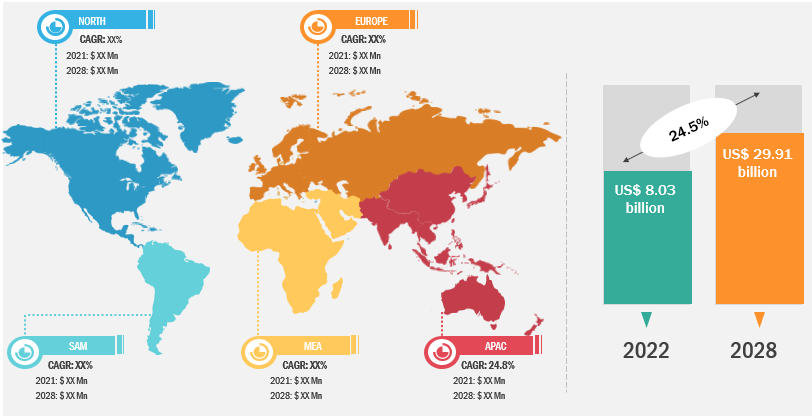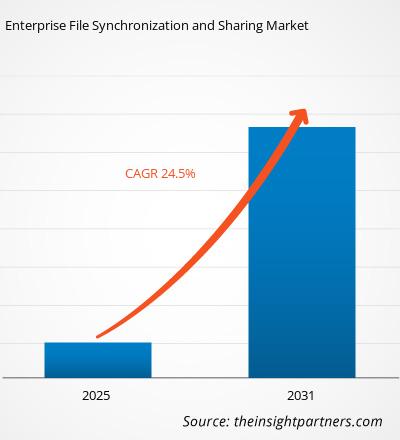Der Markt für Enterprise File Synchronization and Sharing (EFSS) wird voraussichtlich von 8,03 Milliarden US-Dollar wachsen im Jahr 2022 auf 29,91 Milliarden US-Dollar bis 2031; Von 2022 bis 2031 wird ein durchschnittliches jährliches Wachstum von 24,5 % erwartet.
Eine EFSS-Lösung ermöglicht es Einzelpersonen und Organisationen, verschiedene Arten von Dateien innerhalb und außerhalb der Organisation zu teilen und zu synchronisieren, sodass Einzelpersonen, Organisationen und Kunden darauf zugreifen können. EFSS-Lösungen können Organisationen über zwei verschiedene Bereitstellungsmodelle bereitgestellt oder bereitgestellt werden: vor Ort und in der Cloud. Jedes Modell hat Vor- und Nachteile, aber das Cloud-Bereitstellungsmodell ist das am häufigsten verwendete Modell für diesen Markt. Neben der On-Premise- und Cloud-Bereitstellungsart wird das Hybridmodell auch von mehreren Unternehmen übernommen, da es sowohl On-Premise- als auch Cloud-Modellen zugute kommt. Das Hybridsegment hatte im Jahr 2021 einen großen Marktanteil und dürfte im prognostizierten Zeitrahmen ein vielversprechendes Wachstum verzeichnen. Darüber hinaus sind Hybridbereitstellungen komplex und erfordern in der Regel eine sorgfältige Planung und Verwaltung verschiedener Faktoren wie Budgets, Fehler, Sicherheit, Änderungskontrolle und Konfigurationsverwaltung. Der Hybrid-Ansatz ermöglicht es Unternehmen, die Kosteneffizienz und Skalierbarkeit einer reinen Cloud-Umgebung voll auszuschöpfen, ohne kritische Daten und Anwendungen den Schwachstellen Dritter auszusetzen. Daher ist diese Methode ideal für Organisationen, die den Zugriff mobiler Mitarbeiter auf Unternehmensdaten über die Cloud vereinfachen möchten, ohne Datenreplikate in einer Cloud eines Drittanbieters zu erstellen und zu speichern.
Citrix Systems, Inc.; Box Inc.; Dropbox; Microsoft; und Google gehören zu den Hauptakteuren auf dem Markt für Markt für Enterprise File Synchronisation and Sharing (EFSS).
Strategische Einblicke
Regionale Analyse des Marktes für Enterprise File Synchronization and Sharing (EFSS)
Aus regionaler Sicht hält Nordamerika den größten Anteil am EFSS-Markt (Enterprise File Synchronization and Sharing). EFSS-Lösungen werden in den wichtigsten vertikalen Branchen massiv eingesetzt, was voraussichtlich zur höchsten Gesamtumsatzgenerierung weltweit beitragen wird. Die US-Konjunkturprognosen für die IT-Branche sind unsicher. Sie betonen weiterhin den Wandel der Branche von Legacy-Plattformen hin zu Mobil-, Cloud-, Big-Data- und Social-Media-Lösungen, was das Wachstum des Marktes für Enterprise File Synchronisation and Sharing (EFSS) in der Region vorantreibt. Darüber hinaus wird erwartet, dass der asiatisch-pazifische Raum mit der höchsten Wachstumsrate auf dem Markt für Enterprise File Synchronisation and Sharing (EFSS) wachsen wird. Der steigende Bedarf an Flexibilität im gesamten Geschäftsbetrieb hat die Einführung mobiler Apps, Cloud-Software und Automatisierung vorangetrieben. Darüber hinaus beschleunigen der schnelle technologische Fortschritt, die Einführung des Arbeitshybridmodells und der Bedarf an effizienten und kostengünstigen Verwaltungslösungen das Wachstum des Marktes für Enterprise File Synchronisation and Sharing (EFSS) im asiatisch-pazifischen Raum.
Lukrative Regionen für die Dateisynchronisierung in Unternehmen und Sharing (EFSS) Market
 Markteinblicke – Markt für Enterprise File Synchronization and Sharing (EFSS)
Markteinblicke – Markt für Enterprise File Synchronization and Sharing (EFSS)
< strong>Industry Vertical-Based Insights
Basierend auf der Branche Vertikal ist der Markt für Enterprise File Synchronization and Sharing (EFSS) in Gesundheitswesen und Gesundheitsfürsorge unterteilt. Biowissenschaften, BFSI, IT & Telekommunikation, Medien & Unterhaltung, Konsumgüter & Einzelhandel, Industriegüter & Automobil und andere. Im Jahr 2021 werden die IT & Das Telekommunikationssegment hatte den größten Anteil am EFSS-Markt (Enterprise File Synchronization and Sharing). EFSS ermöglicht Unternehmen jeder Größe die Verwaltung, Verfolgung und Auswertung von Kommunikationsprozessen und verbessert die Ressourcenverteilungskanäle, um Aufgaben effektiv auszuführen. Darüber hinaus steigt die Nachfrage nach EFSS in diesem Segment weiter an, da es große Vorteile wie Datenauthentifizierung, Datenreplikation, Synchronisierung von Geschäftsdateien sowie Freigabe- und Zugriffskontrollen bietet, hauptsächlich für Bring Your Own Device (BYOD). Diese Faktoren treiben zusammen den EFSS-Markt (Enterprise File Synchronization and Sharing) für die IT- und IT-Branche voran. Telekommunikationssegment.
Spieler, die im Bereich der Unternehmensdateisynchronisierung und -freigabe (EFSS) tätig sind ) Der Markt konzentriert sich hauptsächlich auf die Entwicklung fortschrittlicher und effizienter Produkte.
- Im September 2022 gingen Google und Instructure, der Entwickler von Elevate Data Sync, eine strategische Partnerschaft ein, um die Lücke für Google Classroom-Kunden zu schließen mit einer robusten Lösung. Darüber hinaus können Bildungseinrichtungen die Synchronisierung der Kursdaten zwischen ihren Studierendeninformationssystemen (SIS) und Google Classroom aufrechterhalten.
- Im Mai 2022 ging Citrix Systems, Inc. eine Partnerschaft mit Microsoft ein, um ein neues Angebot einzuführen: „Citrix HDX Plus für Windows 365.“ Citrix HDX Plus für Windows 365 ermöglicht Benutzern das Speichern, Synchronisieren und Teilen ihrer Arbeitsdateien und konzentriert sich auf die Verbesserung des Cloud-PC-Erlebnisses.
Der Markt für Enterprise File Synchronization and Sharing (EFSS) ist in fünf Hauptregionen unterteilt: Nordamerika, Europa, Asien-Pazifik (APAC), Naher Osten und Südamerika. Im Jahr 2022 war Nordamerika mit einem erheblichen Umsatzanteil Marktführer, gefolgt von Europa. Darüber hinaus wird erwartet, dass der asiatisch-pazifische Raum von 2022 bis 2031 die höchste CAGR im Markt für Enterprise File Synchronisation and Sharing (EFSS) verzeichnen wird.
Citrix Systems, Inc.; Box Inc.; Dropbox; Microsoft; Accellion; VMware, Inc.; Google; Thomson Reuters; IBM Corporation; und OpenText gehören zu den Hauptakteuren auf dem Markt für Enterprise File Synchronisation and Sharing (EFSS). Der Marktbericht bietet detaillierte Markteinblicke, die den Hauptakteuren dabei helfen, Wachstumsstrategien für die kommenden Jahre zu entwickeln.
- Historische Analyse (2 Jahre), Basisjahr, Prognose (7 Jahre) mit CAGR
- PEST- und SWOT-Analyse
- Marktgröße Wert/Volumen – Global, Regional, Land
- Branche und Wettbewerbsumfeld
- Excel-Datensatz



Report Coverage
Revenue forecast, Company Analysis, Industry landscape, Growth factors, and Trends

Segment Covered
This text is related
to segments covered.

Regional Scope
North America, Europe, Asia Pacific, Middle East & Africa, South & Central America

Country Scope
This text is related
to country scope.
Trends and growth analysis reports related to Technology, Media and Telecommunications : READ MORE..
The List of Companies
- Accellion, Inc
- Box, Inc.
- Citrix Systems, Inc.
- Dropbox, Inc
- Egnyte, Inc.
- Google,Inc.
- Microsoft Corporation
- SugarSync, Inc.
- Syncplicity LLC
- VMware, Inc.
The Insight Partners performs research in 4 major stages: Data Collection & Secondary Research, Primary Research, Data Analysis and Data Triangulation & Final Review.
- Data Collection and Secondary Research:
As a market research and consulting firm operating from a decade, we have published and advised several client across the globe. First step for any study will start with an assessment of currently available data and insights from existing reports. Further, historical and current market information is collected from Investor Presentations, Annual Reports, SEC Filings, etc., and other information related to company’s performance and market positioning are gathered from Paid Databases (Factiva, Hoovers, and Reuters) and various other publications available in public domain.
Several associations trade associates, technical forums, institutes, societies and organization are accessed to gain technical as well as market related insights through their publications such as research papers, blogs and press releases related to the studies are referred to get cues about the market. Further, white papers, journals, magazines, and other news articles published in last 3 years are scrutinized and analyzed to understand the current market trends.
- Primary Research:
The primarily interview analysis comprise of data obtained from industry participants interview and answers to survey questions gathered by in-house primary team.
For primary research, interviews are conducted with industry experts/CEOs/Marketing Managers/VPs/Subject Matter Experts from both demand and supply side to get a 360-degree view of the market. The primary team conducts several interviews based on the complexity of the markets to understand the various market trends and dynamics which makes research more credible and precise.
A typical research interview fulfils the following functions:
- Provides first-hand information on the market size, market trends, growth trends, competitive landscape, and outlook
- Validates and strengthens in-house secondary research findings
- Develops the analysis team’s expertise and market understanding
Primary research involves email interactions and telephone interviews for each market, category, segment, and sub-segment across geographies. The participants who typically take part in such a process include, but are not limited to:
- Industry participants: VPs, business development managers, market intelligence managers and national sales managers
- Outside experts: Valuation experts, research analysts and key opinion leaders specializing in the electronics and semiconductor industry.
Below is the breakup of our primary respondents by company, designation, and region:

Once we receive the confirmation from primary research sources or primary respondents, we finalize the base year market estimation and forecast the data as per the macroeconomic and microeconomic factors assessed during data collection.
- Data Analysis:
Once data is validated through both secondary as well as primary respondents, we finalize the market estimations by hypothesis formulation and factor analysis at regional and country level.
- Macro-Economic Factor Analysis:
We analyse macroeconomic indicators such the gross domestic product (GDP), increase in the demand for goods and services across industries, technological advancement, regional economic growth, governmental policies, the influence of COVID-19, PEST analysis, and other aspects. This analysis aids in setting benchmarks for various nations/regions and approximating market splits. Additionally, the general trend of the aforementioned components aid in determining the market's development possibilities.
- Country Level Data:
Various factors that are especially aligned to the country are taken into account to determine the market size for a certain area and country, including the presence of vendors, such as headquarters and offices, the country's GDP, demand patterns, and industry growth. To comprehend the market dynamics for the nation, a number of growth variables, inhibitors, application areas, and current market trends are researched. The aforementioned elements aid in determining the country's overall market's growth potential.
- Company Profile:
The “Table of Contents” is formulated by listing and analyzing more than 25 - 30 companies operating in the market ecosystem across geographies. However, we profile only 10 companies as a standard practice in our syndicate reports. These 10 companies comprise leading, emerging, and regional players. Nonetheless, our analysis is not restricted to the 10 listed companies, we also analyze other companies present in the market to develop a holistic view and understand the prevailing trends. The “Company Profiles” section in the report covers key facts, business description, products & services, financial information, SWOT analysis, and key developments. The financial information presented is extracted from the annual reports and official documents of the publicly listed companies. Upon collecting the information for the sections of respective companies, we verify them via various primary sources and then compile the data in respective company profiles. The company level information helps us in deriving the base number as well as in forecasting the market size.
- Developing Base Number:
Aggregation of sales statistics (2020-2022) and macro-economic factor, and other secondary and primary research insights are utilized to arrive at base number and related market shares for 2022. The data gaps are identified in this step and relevant market data is analyzed, collected from paid primary interviews or databases. On finalizing the base year market size, forecasts are developed on the basis of macro-economic, industry and market growth factors and company level analysis.
- Data Triangulation and Final Review:
The market findings and base year market size calculations are validated from supply as well as demand side. Demand side validations are based on macro-economic factor analysis and benchmarks for respective regions and countries. In case of supply side validations, revenues of major companies are estimated (in case not available) based on industry benchmark, approximate number of employees, product portfolio, and primary interviews revenues are gathered. Further revenue from target product/service segment is assessed to avoid overshooting of market statistics. In case of heavy deviations between supply and demand side values, all thes steps are repeated to achieve synchronization.
We follow an iterative model, wherein we share our research findings with Subject Matter Experts (SME’s) and Key Opinion Leaders (KOLs) until consensus view of the market is not formulated – this model negates any drastic deviation in the opinions of experts. Only validated and universally acceptable research findings are quoted in our reports.
We have important check points that we use to validate our research findings – which we call – data triangulation, where we validate the information, we generate from secondary sources with primary interviews and then we re-validate with our internal data bases and Subject matter experts. This comprehensive model enables us to deliver high quality, reliable data in shortest possible time.

 Holen Sie sich ein kostenloses Muster für diesen Bericht
Holen Sie sich ein kostenloses Muster für diesen Bericht